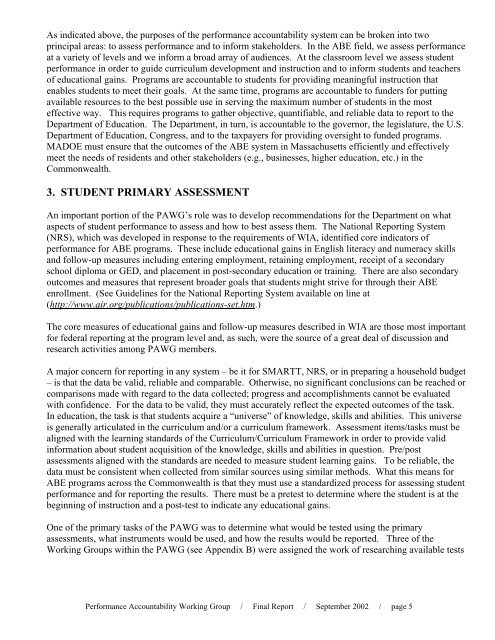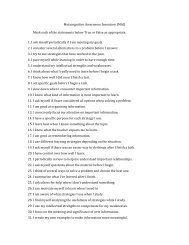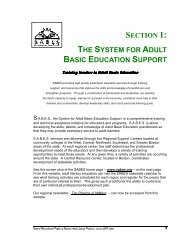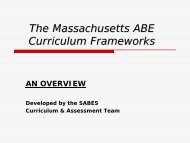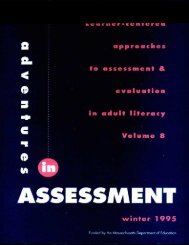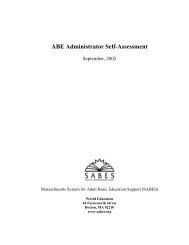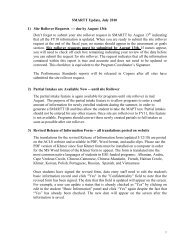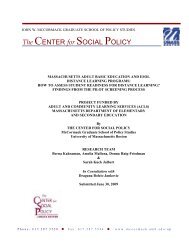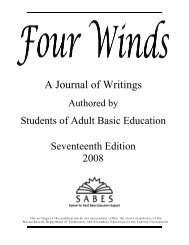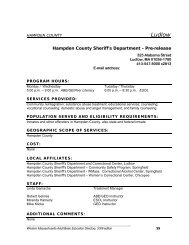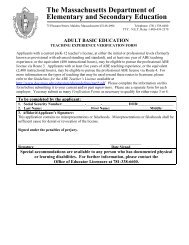PAWG I Final Report - SABES
PAWG I Final Report - SABES
PAWG I Final Report - SABES
Create successful ePaper yourself
Turn your PDF publications into a flip-book with our unique Google optimized e-Paper software.
As indicated above, the purposes of the performance accountability system can be broken into two<br />
principal areas: to assess performance and to inform stakeholders. In the ABE field, we assess performance<br />
at a variety of levels and we inform a broad array of audiences. At the classroom level we assess student<br />
performance in order to guide curriculum development and instruction and to inform students and teachers<br />
of educational gains. Programs are accountable to students for providing meaningful instruction that<br />
enables students to meet their goals. At the same time, programs are accountable to funders for putting<br />
available resources to the best possible use in serving the maximum number of students in the most<br />
effective way. This requires programs to gather objective, quantifiable, and reliable data to report to the<br />
Department of Education. The Department, in turn, is accountable to the governor, the legislature, the U.S.<br />
Department of Education, Congress, and to the taxpayers for providing oversight to funded programs.<br />
MADOE must ensure that the outcomes of the ABE system in Massachusetts efficiently and effectively<br />
meet the needs of residents and other stakeholders (e.g., businesses, higher education, etc.) in the<br />
Commonwealth.<br />
3. STUDENT PRIMARY ASSESSMENT<br />
An important portion of the <strong>PAWG</strong>’s role was to develop recommendations for the Department on what<br />
aspects of student performance to assess and how to best assess them. The National <strong>Report</strong>ing System<br />
(NRS), which was developed in response to the requirements of WIA, identified core indicators of<br />
performance for ABE programs. These include educational gains in English literacy and numeracy skills<br />
and follow-up measures including entering employment, retaining employment, receipt of a secondary<br />
school diploma or GED, and placement in post-secondary education or training. There are also secondary<br />
outcomes and measures that represent broader goals that students might strive for through their ABE<br />
enrollment. (See Guidelines for the National <strong>Report</strong>ing System available on line at<br />
(http://www.air.org/publications/publications-set.htm.)<br />
The core measures of educational gains and follow-up measures described in WIA are those most important<br />
for federal reporting at the program level and, as such, were the source of a great deal of discussion and<br />
research activities among <strong>PAWG</strong> members.<br />
A major concern for reporting in any system – be it for SMARTT, NRS, or in preparing a household budget<br />
– is that the data be valid, reliable and comparable. Otherwise, no significant conclusions can be reached or<br />
comparisons made with regard to the data collected; progress and accomplishments cannot be evaluated<br />
with confidence. For the data to be valid, they must accurately reflect the expected outcomes of the task.<br />
In education, the task is that students acquire a “universe” of knowledge, skills and abilities. This universe<br />
is generally articulated in the curriculum and/or a curriculum framework. Assessment items/tasks must be<br />
aligned with the learning standards of the Curriculum/Curriculum Framework in order to provide valid<br />
information about student acquisition of the knowledge, skills and abilities in question. Pre/post<br />
assessments aligned with the standards are needed to measure student learning gains. To be reliable, the<br />
data must be consistent when collected from similar sources using similar methods. What this means for<br />
ABE programs across the Commonwealth is that they must use a standardized process for assessing student<br />
performance and for reporting the results. There must be a pretest to determine where the student is at the<br />
beginning of instruction and a post-test to indicate any educational gains.<br />
One of the primary tasks of the <strong>PAWG</strong> was to determine what would be tested using the primary<br />
assessments, what instruments would be used, and how the results would be reported. Three of the<br />
Working Groups within the <strong>PAWG</strong> (see Appendix B) were assigned the work of researching available tests<br />
Performance Accountability Working Group / <strong>Final</strong> <strong>Report</strong> / September 2002 / page 5


